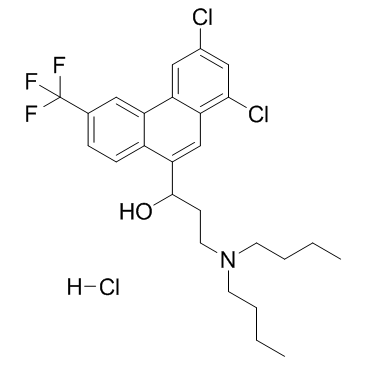36167-63-2
| Name | Halofantrine Hydrochloride |
|---|---|
| Synonyms |
9-phenanthrenemethanol, 1,3-dichloro-α-[2-(dibutylamino)ethyl]-6-(trifluoromethyl)-, hydrochloride
UNII:2B7ENL644K 3-(Dibutylamino)-1-[1,3-dichlor-6-(trifluormethyl)phenanthren-9-yl]propan-1-olhydrochlorid MFCD00879136 3-(Dibutylamino)-1-[1,3-dichloro-6-(trifluoromethyl)-9-phenanthryl]propan-1-ol hydrochloride (1:1) 3-(dibutylamino)-1-[1,3-dichloro-6-(trifluoromethyl)phenanthren-9-yl]propan-1-ol hydrochloride EINECS 252-895-4 3-(dibutylamino)-1-[1,3-dichloro-6-(trifluoromethyl)phenanthren-9-yl]propan-1-ol hydrochloride (1:1) 3-(Dibutylamino)-1-[1,3-dichloro-6-(trifluoromethyl)-9-phenanthryl]-1-propanol hydrochloride (1:1) 9-Phenanthrenemethanol, 1,3-dichloro-α-[2-(dibutylamino)ethyl]-6-(trifluoromethyl)-, hydrochloride (1:1) Halofantrine hydrochloride 3-(dibutylamino)-1-[1,3-dichloro-6-(trifluorométhyl)phénanthrén-9-yl]propan-1-ol chlorhydrate UNII:H77DL0Y630 |
| Description | Halofantrine hydrochloride (SKF-102886) is a blocker of delayed rectifier potassium current via the inhibition of human-ether-a-go-go-related gene (HERG) channel and a potent antimalarial compound[1][2]. |
|---|---|
| Related Catalog | |
| Target |
Malaria[1].HERG channel[2]. |
| References |
| Density | 1.244g/cm3 |
|---|---|
| Boiling Point | 596.2ºC at 760mmHg |
| Molecular Formula | C26H31Cl3F3NO |
| Molecular Weight | 536.885 |
| Flash Point | 314.4ºC |
| Exact Mass | 535.142334 |
| PSA | 23.47000 |
| LogP | 9.44630 |
| Storage condition | 2-8°C |
CHEMICAL IDENTIFICATION
HEALTH HAZARD DATAACUTE TOXICITY DATA
|
| Hazard Statements | H413 |
|---|---|
| Personal Protective Equipment | Eyeshields;Gloves;type N95 (US);type P1 (EN143) respirator filter |
| RIDADR | NONH for all modes of transport |
| RTECS | SF7790000 |
